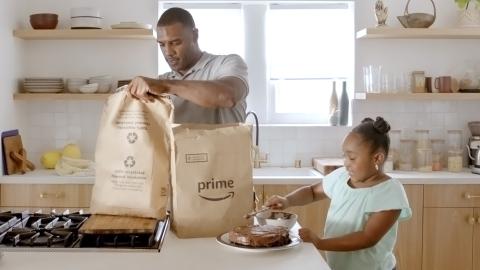Amazon Makes Grocery Delivery More Sustainable

With so many more consumers ordering their groceries online, Amazon is taking a major step in making all of that pickup and delivery better for the planet.
The company is launching new curbside recyclable packaging that keeps grocery items chilled and frozen during delivery.
Rolling out just in time for Thanksgiving when customers are ordering turkey, green beans, or frosty pints of ice cream, chilled and frozen foods from Amazon Fresh and Whole Foods Market will arrive insulated in packaging made from recycled paper, permanently eliminating the need for plastic liners and bubble bag insulation. The new packaging is also easier for customers to recycle at home.
According to the company, moving to all curbside-recyclable insulation packaging reduces material waste, and each year replaces approximately 735,000 pounds of plastic film, 3.15 million pounds of natural cotton fiber, and 15 million pounds of non-recyclable mixed plastic. This new packaging is the latest step in Amazon’s commitment to The Climate Pledge, a bold commitment to be net-zero carbon across its business by 2040, and to building a more sustainable business.
Stephenie Landry, Vice President, Amazon Grocery, detailed the company's latest journey to recyclable packaging journey in a new blog post:
How would you describe the problem we were trying to solve for customers?
We have long wanted to find a more sustainable solution for the plastic liners and bubble bags that are often used to insulate chilled and frozen items. The criteria for any new packaging solution came down to five key considerations. First, and probably the most obvious, we wanted to ensure the packaging maintained product chill chain and Amazon’s high bar for food safety.
Second, the packaging needed to be small, compact, and flexible for our delivery drivers. Think of it as fitting multiple grocery bags into the trunk of a Prius, so switching to stiff cardboard boxes for insulation wouldn’t work. Although they’d maintain food-safe temperatures, boxes would take up more room, which would mean fewer grocery deliveries per vehicle, ultimately resulting in more vehicles—and carbon emissions.
The third major consideration was that any new packaging needed to be easily recyclable—as in, customers could leave it with the rest of their curbside recyclable material. Fourth, it also needed to be inexpensive and scalable because we wanted to continue to ensure that Amazon’s grocery delivery offerings were widely accessible for customers.
And finally, we wanted to generate less overall packaging for customers. We are continually inventing new packaging solutions, and sometimes the simplest action is to use less of it, especially when Mother Nature provides her own “chill chain” in colder months.
Landry shares more details in her blog post here.
In October, Amazon forecast modest sales growth for the fourth quarter. The bleak holiday season outlook came as Amazon reported sales for its third quarter increased 15% to $110.8 billion, within the company’s forecast range of $106 billion to $112 billion shared at the end of the second quarter. That’s impressive growth, but profits were a different story: Net income fell to $3.2 billion and earnings per share fell to $6.12 from net income during the prior-year third quarter of $6.3 billion and earnings per share of $12.37.
Expenses rose in key areas, which CEO Andy Jassy positioned as the company doing right by customers rather than maximizing near-term profits. For example, fulfillment expenses increased 27.8% to $18.5 billion, technology and content expenses increased 31% to $14.4 billion, and marketing expenses increased 47.4% to $8 billion. Customers appreciated Amazon’s commitment, which is part of what drove the 39% growth in AWS revenue, according to Jassy.
“It’s also driven extraordinary investments across our businesses to satisfy customer needs. Just one example is that we’ve nearly doubled the size of our fulfillment network since the pandemic began,” Jassy said. “In the fourth quarter, we expect to incur several billion dollars of additional costs in our consumer business as we manage through labor supply shortages, increased wage costs, global supply chain issues, and increased freight and shipping costs, all while doing whatever it takes to minimize the impact on customers and selling partners this holiday season.
Seattle-based Amazon is No. 2 on Progressive Grocer’s 2021 list of the top food and consumables retailers in North America, while its wholly owned subsidiary, Austin, Texas-based Whole Foods, is No. 26 on PG's list.



